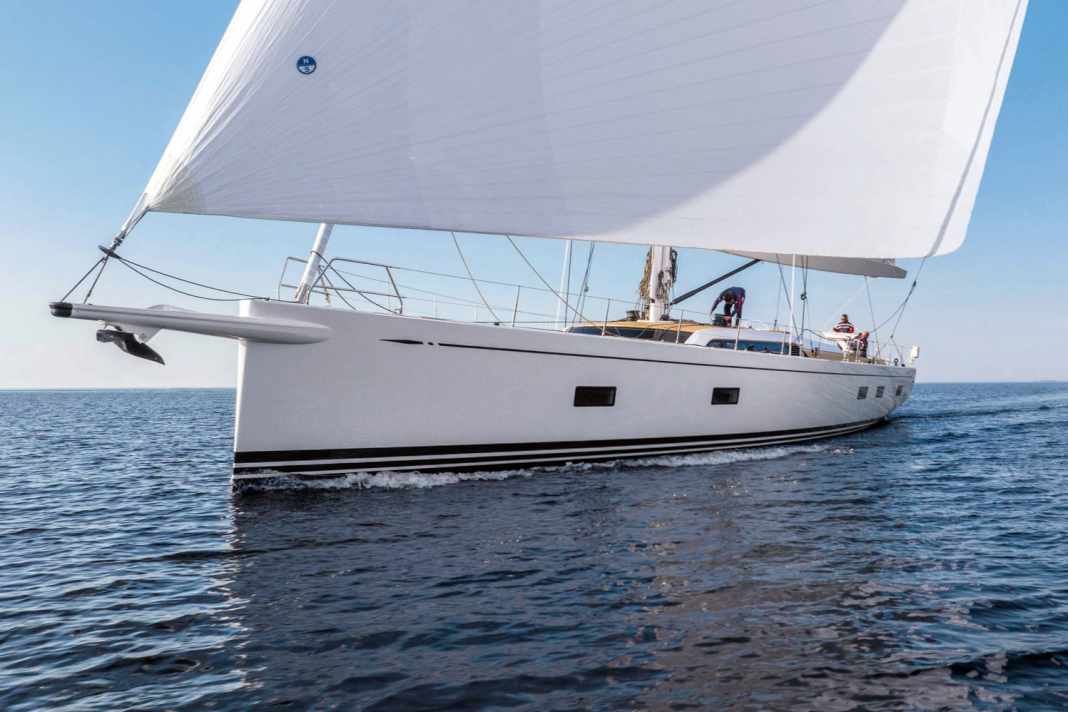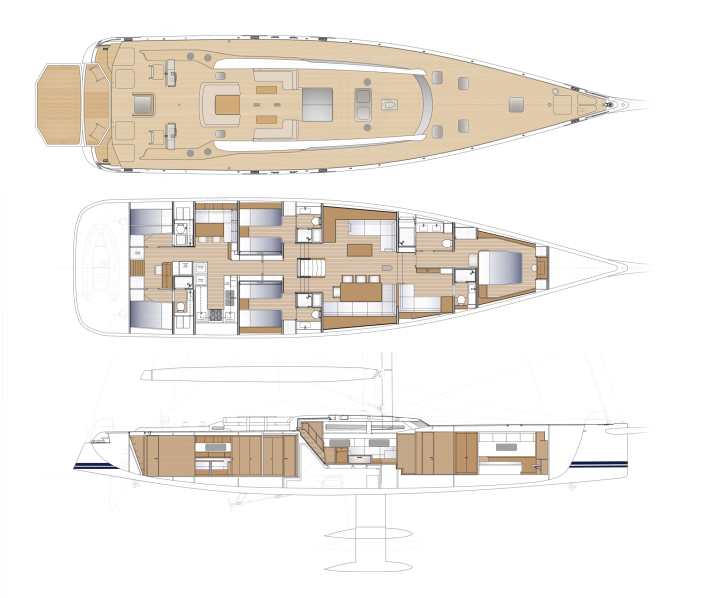Swan 88: Nautor creates sailing self-sufficiency thanks to electrification
Sören Gehlhaus
· 20.10.2024






Early June in Pietarsaari, Finland. The sunlit sky displays a clarity that only the far north can produce. This makes the 14 yachts moored in the harbour appear even more immaculate and enhances the cool, elegant charm that has always surrounded Nautor's Swans. The first Swan 88 is moored at the far end of the quay, behind the regatta-trimmed build number two. The dock check of "DreamCatcher" shows new features from bow to stern.
For example, the bowsprit, which does not originate from the foredeck, but is positioned further down as an extension of Nautor's spearhead moulding. This means that the anchor hangs lower, making it less likely to touch the stern during the haul-out. Code Zero and gennaker also catch a little more wind. The long trunk of the 88 ends in a black attachment via a bead. The top-down furler's jib line or tackle runs out of the tip of the nose at the top and not at the front, which reduces friction.
Also interesting:
While Germán Frers has been the designer in charge of the final shape for the past 40 years, much like the engineers at Porsche once did, it is now a collaboration with designer Lucio Micheletti who is reworking the exterior of all Swan models. The architect and his Milan team adapted the cabin structure of the 88 to that of the 108 and devised a new stern: two wide steps lead up to a narrow intermediate deck, from which a hexagonal piece forms the two-metre-long bathing platform together with the large hatch of the transom.
Cooperation with the Bavarian company Torqeedo
Nautor's sense for practical details is also evident in the stepped stern: it brings the certified hull length to less than 24 metres and contains stainless steel cleats that sort the stern lines and spring. And in front of the free-standing parts of the rudder, small stainless steel blades prevent "by-catch" such as algae from settling between the blade and the underwater hull. The tender with Torqeedo Cruise 12.0 E outboard is on land and not yet in the garage, a first indication of the mother's hybrid drive.
Outside the harbour, the aim is to motor towards the sea breeze, although it feels more like constantly pushing away. No jerking, no smoke, hardly any noise. And this despite the fact that the two 45-kilowatt generators initially powered the electric drive unit via the batteries. The hybrid solution was an absolute prerequisite for the sale of the first Swan 88: "Otherwise there would have been no deal," explains Thorsten Flack, leaning against the pushpit. It was also the Swan salesman who initiated the collaboration with the Bavarian company Torqeedo, which had already launched its Deep Blue system in the Spirit 111 "Spirit" installed.
For "DreamCatcher", the engineers developed a 120 kilowatt electric motor with high torque, which now drives the large controllable pitch propeller at nine knots with 60 kilowatts. Stephan Bayerle, Head of OEM Solutions at Torqeedo, explains on the B&G display: "Both generators run at 27.5 kilowatts, which is the most efficient way to charge." Once the batteries have been sufficiently topped up, it is time to let the generators rest. Below deck, the noise level is reduced even further. A sense of silence, nothing vibrates. Only in the engine room, which can be reached via the saloon floor or the rear of the companionway, can the whirring of the frequency converter be heard.
As the engine compartment has the same dimensions as in the diesel-only version, the saloon has a headroom of two metres, which is continued in the four guest cabins. The interior is characterised by minimally treated oak from Finland, which covers the walls in veneered form on foam cores and the bulkheads with a sound-absorbing rubber layer. The companionway is surrounded by a kind of atrium, from which two guest lounges lead off. "We're sailing!" can be heard from above. The change in mode of transport was not noticeable in the front of the owner's cabin.
Emission-free for a distance of 40 nautical miles
The sail systems do not use auxiliary drives (PTO), so no generators need to be activated. The hydraulics are pressurised and the winches, bow and stern thrusters and anchor are moved by a 50-kilowatt electric motor, which is also powered by the four batteries, each with a capacity of 40 kilowatt hours. The seawater-cooled BMW batteries, two of which are stored in the foredeck, supply energy-hungry consumers such as air conditioning or kitchen appliances for up to twelve hours. Direct current consumers such as lighting and entertainment electronics are supplied by 24-volt batteries. The 22-kilowatt on-board charger fills the power storage units completely when the generators are running for 1.5 hours. With shore power, a full charge takes a little less than six hours.
Atlantic calms are mastered at 7.5 knots over a distance of 40 nautical miles with zero emissions. Nautor's project manager Kim Sundkvist points out: "It's okay to go up to 20 per cent of the charge level, we've been below that before. If you do this regularly, the service life is shortened. Between 95 and 20 per cent is good, which would be 75 per cent of the total capacity, i.e. 120 kilowatt hours. We used this value to calculate the range." With both generators and a full 2,800-litre tank, the range can be extended to up to 2,000 nautical miles.
The wind climbs to over eight knots in gusts, the Code Zero is rolled out quickly and we scrape nine knots of boat speed on sharp courses. Good conditions for spreading the wings of the Hundested prop at the touch of a button on Torqeedo's command transmitter. "We recommend hydrogeneration from a speed of 8.5 knots. Then the output is similar to that of a diesel generator on a 50-footer," says Sundkvist. Now, at the lower end of the scale, we are harvesting 5.3 kilowatts of energy.
Decision in favour of electrification a question of attitude
The 88 is easy to steer thanks to double rudder blades, whose quadrants connect chain hoists and push rods, as with all Swans. The perfect angle for sporty sailing is between 22 and 23 degrees and 15 degrees for relaxed cruising, which the "DreamCatcher" owners prefer.
The number that most aptly describes the hybrid drive is 1.5. In tonnes, it stands for the extra weight that comes on board, even though it is below the waterline. The surcharge should also roughly correspond to this value - millions of euros before the unit. And the loss of speed with hydrogeneration? About 1.5 knots.
The decision in favour of electrification still seems to be a question of attitude. Nautor CEO Giovanni Pomati reported on customers whose children travelled to Finland by train and not by private jet. With batteries becoming lighter and cheaper, performance-oriented and sceptical owners should also be won over.
The Swan 88 is already catering for one trend: downsizing. Although she measures 26.54 metres overall, with a hull length of just under 24 metres, she fits into a popular size segment in regulatory terms. This means she can anchor closer to the coast in parts of France, is cheaper and more flexible to sail and easier to charter. Nautor will soon be meeting the new mini-maxi demand with the 80, which, however, does not have a stepped stern.
The Swan 88 "Dreamcatcher" in detail

Technical data
- Length over everything: 26,54 m
- Length (hull shape): 23,99 m
- Width: 6,79 m
- Depth: 4,00 m
- Displacement (empty): 54,1 t
- Material: Carbon Rigg: Hall Spars
- Mast height above deck: 38,30 m
- Sail: North Sails 3Di
- Sail area (on the wind): 432,7 m2
- E-motor: Torqeedo Deep Blue, 120 kW
- Batteries: BMW, 4 x 40 kWh
- Generators: 2 x 45 kW
- Fuel: 2.800 l
- Water: 1.500 l
Plenty of cubage
A high freeboard, projecting stern and carbon construction ensure a high interior volume. The Finns always locate the owner's cabin in the foredeck. On the starboard side behind it, customers can choose between a lounge or a fourth guest cabin. Four crew berths are located aft behind the open galley.

